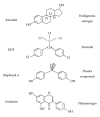Estrogen Deficiency and the Origin of Obesity during Menopause
- PMID: 24734243
- PMCID: PMC3964739
- DOI: 10.1155/2014/757461
Estrogen Deficiency and the Origin of Obesity during Menopause
Abstract
Sex hormones strongly influence body fat distribution and adipocyte differentiation. Estrogens and testosterone differentially affect adipocyte physiology, but the importance of estrogens in the development of metabolic diseases during menopause is disputed. Estrogens and estrogen receptors regulate various aspects of glucose and lipid metabolism. Disturbances of this metabolic signal lead to the development of metabolic syndrome and a higher cardiovascular risk in women. The absence of estrogens is a clue factor in the onset of cardiovascular disease during the menopausal period, which is characterized by lipid profile variations and predominant abdominal fat accumulation. However, influence of the absence of these hormones and its relationship to higher obesity in women during menopause are not clear. This systematic review discusses of the role of estrogens and estrogen receptors in adipocyte differentiation, and its control by the central nervous systemn and the possible role of estrogen-like compounds and endocrine disruptors chemicals are discussed. Finally, the interaction between the decrease in estrogen secretion and the prevalence of obesity in menopausal women is examined. We will consider if the absence of estrogens have a significant effect of obesity in menopausal women.
Figures




References
-
- Mendez MA, Monteiro CA, Popkin BM. Overweight exceeds underweight among women in most developing countries. American Journal of Clinical Nutrition. 2005;81(3):714–721. - PubMed
-
- Olszowy KM, Dufour DL, Bender RL, Bekelman TA, Reina JC. Socioeconomic status, stature, and obesity in women: 20-year trends in urban Colombia. American Journal of Human Biology. 2012;24:602–610. - PubMed
-
- Heitmann BL, Westerterp KR, Loos RJ, et al. Obesity: lessons from evolution and the environment. Obesity Reviews. 2012;13:910–922. - PubMed
Publication types
MeSH terms
Substances
LinkOut - more resources
Full Text Sources
Other Literature Sources
Medical

